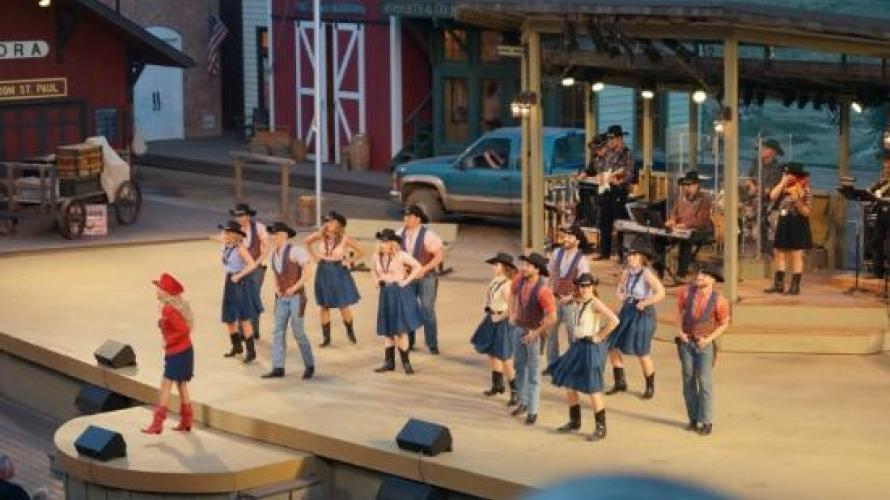

Robyn L. Erlenbush is a third-generation Montanan who lives in Bozeman, MT. She is the broker/owner of ERA Landmark Real Estate (with offices in Bozeman, Big Sky, Livingston and Clyde Park), NAI Landmark Commercial and Intermountain Property Management. She can be reached at [email protected].
* * * * * *
One of my favorite childhood memories was our family road trip every year in August to watch a performance of the Medora Musical. We carefully planned and anticipated this reward to celebrate the end of haying season. From stories of Theodore Roosevelt and his Rough Riders, songs from the Burning Hills Singers, to Victor Julian and his acrobatic poodles, the show was the high point of our summer. I am certain that our family attended most every year from the early 1960s to the late 1970s. I came to admire the predictability, pageantry and the patriotism. From the all-American cast (mostly North Dakota, Montana and Mid-West college students) of talented singers and dancers to Teddy’s famous charge up San Juan Hill, we enjoyed it all.
Every summer I would practice racing my sorrel-colored Quarter Horse, Little Red, up the steepest hill I could find, while singing the signature tune at the top of my lungs… “the Badlands, the blue skies of the shining West, Dakota! Dakota! by the Heavens blest.” Sadly, I never mastered “trick roping” and my Collie, Ladybird (named after our First Lady, Ladybird Johnson) refused to learn a back flip, and so I did not achieve my childhood dream of becoming a cast member of the Burning Hills Singers and performing on the Medora stage.
I grew up on a cattle and sheep ranch twenty miles southeast of Baker, MT. Our ranchland bordered the Little Beaver Oil Field and our ranch crew (consisting only of my mother and her two young daughters) prayed faithfully for an oil or gas well to be drilled on our land. Life was simple, long days filled with hard work and hot summer nights spent outdoors grilling BBQ steaks, toasting white bread for garlic toast and drizzling Good Seasons vinaigrette dressing over our fresh garden lettuce. We were in love with show tunes and musicals, and Medora served as our closest live stage.
But Medora is far more than just the past fifty years and current cast of characters and activities such as the nightly pitchfork fondue, musical production, Chateau de Mores tour, TR National Park or the breath-taking, yet challenging Bully Pulpit Golf Course. Its history is as rich and fascinating as the stunning terrain and scenic beauty. Here are a few of my favorite frontiersmen that might have merely passed through or put down roots and left their legacy on this part of the state and helped shape our country.
Among the first outsiders to visit was Jean Baptist LePage, a Canadian voyager and fur trapper, who in 1804 joined up with the Lewis and Clark expedition at their winter camp on the Missouri River.
General Alfred Sully lead two thousand troops and a civilian wagon trail through in 1864. They encountered and fought the Lakota and the Sioux warriors at the “Battle of the Badlands.”
Pierre Jean De Smet traveled on a mission of peace in 1868. He was a Jesuit missionary who met with Sitting Bull and the Hunkpapa Lakota tribe.
The infamous military leader, Lieutenant Colonel George Armstrong Custer, traveled through Medora with the Seventh Calvary on their way to fight the ill-fated Battle of the Little Big Horn near Hardin, MT on June 25, 1876.
Now enter the two lead characters in 1883 that had a more lasting impact and laid the foundation of Medora today. Both were courageous, daring, adventuresome and fearless at the ripe old age of twenty-four on their first visit. One was a French nobleman who chose to make Medora his place of business and home. The other, a young politician and “Big Game” hunter named Teddy Roosevelt, came in pursuit of buffalo.
Marquis de Mores founded the town of Medora, naming it after his young wife. He had a vision for revolutionizing the cattle industry by building a meat packing plant and shipping processed beef via refrigerated rail cars back to Chicago. His business venture failed miserably, but he left behind a historic chateau, which has been beautifully restored and serves as a reminder of the astounding grace, wealth and elegance of Medora de Mores.
Meanwhile, Theodore Roosevelt, in search of a prize buffalo trophy, is captivated with the “Badlands”, invests in a local ranch and becomes a part-time resident. He is struck by the decimation of the wild bison herds and the damage being done to the native lands and its wildlife. In 1901, at age forty-two, he becomes the youngest US president. He passionately acts to preserve and protect the West by establishing the US Forest Service and signing the 1906 Antiquities Acts proclaiming eighteen national monuments. He also establishes five additional national parks, fifty-one federal bird reserves, four national game preserves, and one hundred and fifty National Forests. He succeeds in placing two hundred and thirty million acres in public protected land. And he lives on still today “larger than life” while leading the charge up the San Juan Hill every summer night for the past forty-eight years.
All in all, the 1800s were fascinating times for this sleepy little town. Fast forward to the present, and while on a personal note, I did not become a Burning Hills Singer, a professional trick roper or a dog whisperer, my family continues to hope and pray for the “big one” to be drilled. Maybe this year, you will join our family on some warm summer night for a steak, musical performance and charge up the hill during the 49th season of the Medora Musical. (Medora is located 60 miles east of Glendive, MT and 37 miles west of Dickerson, North Dakota. Visit Medora.com for full details.)
~
